Have you ever wondered how long do giraffes sleep? How the world’s tallest mammals manage to survive on just a few minutes of sleep at a time? In a world where most animals need hours of rest to function, giraffes seem to defy the rules of nature.
Giraffes are not only remarkable for their incredible height and graceful stride but also for their unique sleeping habits. Unlike many animals that spend a significant portion of their day resting, giraffes sleep for a surprisingly short amount of time. Their sleep patterns are as unique as they are puzzling, raising intriguing questions about how these majestic creatures manage to stay alert and active despite minimal rest.
This article aims to uncover the mysteries of giraffe sleep. We will explore How Long Do Giraffes Sleep, the reasons behind their brief sleep periods, how their sleep habits have evolved, and what factors influence their ability to function with so little rest. By the end of this journey, you’ll gain a deeper understanding of how giraffes have adapted to their environment and the extraordinary ways in which they conserve energy and stay safe from predators while sleeping.
For more in-depth information on giraffe conservation efforts and how you can help, visit the Giraffe Conservation Foundation.
| Common Name | Giraffe |
| Scientific Name | Giraffa camelopardalis |
| Family Name | Giraffidae |
| Type | Mammal |
| Size | Head and body length: 4.3-5.7 meters (14.1-18.7 feet) Tail length: 76-101 centimeters (2.5-3.3 feet) |
| Weight | 800-1,200 kilograms (1,764-2,646 pounds) |
| Size Relative to a 6-Ft Human | Significantly taller, standing over twice the height |
| Diet | Herbivore (primarily leaves, shoots, and fruits from trees, especially acacia trees) |
| Average Lifespan in the Wild | 25 years |
| Habitat | Savannas, grasslands, and open woodlands |
| Group Name | Tower (when stationary), Journey (when moving) |
| Found In | Sub-Saharan Africa |
| Conservation Status | Vulnerable (IUCN Red List) |
1. Understanding Giraffe Sleep Patterns
1.1 How Long Do Giraffes Sleep?
Typical Sleep Duration of Giraffes:
Giraffes are unique in the animal kingdom when it comes to their sleep patterns. On average, a giraffe only sleeps for about 4.6 hours in a 24-hour period. However, this sleep is not continuous; it is often broken up into short naps that last just a few minutes at a time. This fragmented sleep cycle is one of the shortest among mammals, a fascinating aspect of giraffe biology.
Why Their Sleep Is So Brief?
The brief sleep duration of giraffes is largely due to the need for constant vigilance in their natural habitats. As prey animals, giraffes are vulnerable to predators like lions and hyenas. To reduce the risk of being caught off-guard, they have evolved to sleep in short bursts, allowing them to remain alert for most of the day and night. Additionally, their massive size and long necks make lying down and getting back up a cumbersome process, further influencing their need to remain on their feet for most of the time.
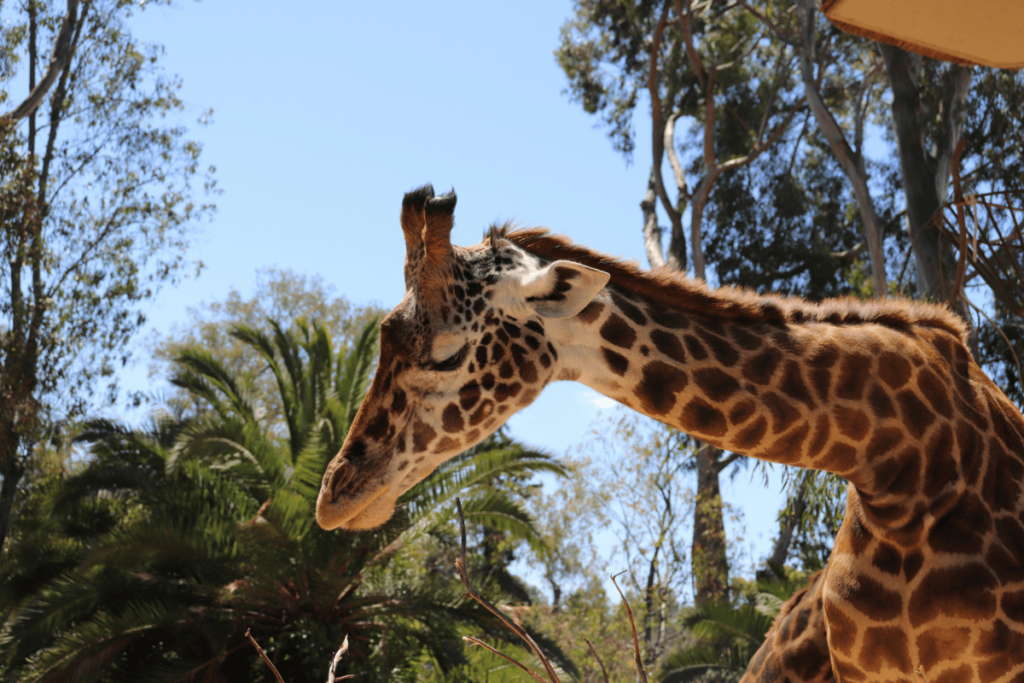
1.2 How Do Giraffes Sleep?
Sleeping Behavior of Giraffes:
Giraffe sleep behavior is as unusual as their sleep duration. Unlike many animals that find a comfortable spot to lay down and rest, giraffes often sleep standing up. Their sleep usually consists of a series of short naps taken throughout the day and night. During these naps, a giraffe will often stand still, with its legs locked in place, while its neck and head droop slightly. In some instances, especially when they feel safe, giraffes may kneel down and fold their legs beneath them to take a brief nap.
Whether Giraffes Sleep Standing Up or Lying Down?
While giraffes can sleep standing up, they sometimes lie down to rest, though this is less common due to the risks involved. When they do lie down, giraffes fold their legs under their bodies and may rest their heads on their rumps or on the ground. This position allows them to enter a deeper sleep phase known as rapid eye movement (REM) sleep, though they only stay in this state for a few minutes at a time. However, lying down makes them more vulnerable to predators, which is why they usually opt to sleep standing up, ready to flee if danger approaches.
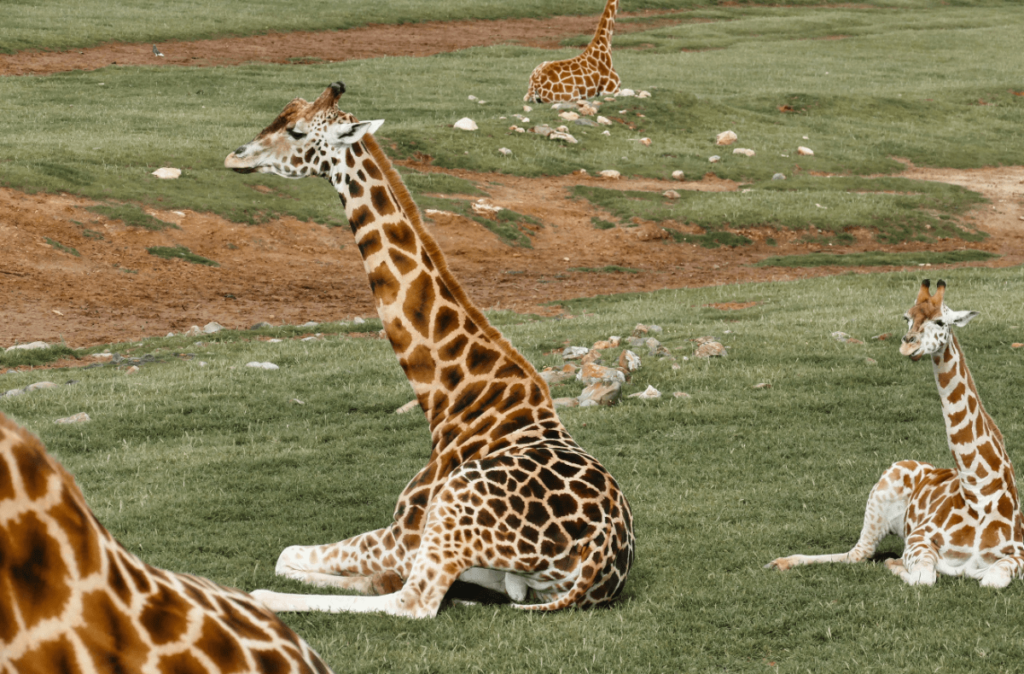
2. Giraffe Sleep Mechanics
2.1 Giraffe Sleep Anatomy
Giraffe Physiology and Sleep:
- Giraffes possess a highly specialized anatomy that plays a critical role in their sleep patterns. Their extraordinary height, with an average of 16-18 feet (5-5.5 meters) for males, and their long legs and necks create unique challenges for sleeping.
- The giraffe’s heart is designed to pump blood up to its brain, which is about 8 feet (2.5 meters) above its heart when standing. This unique cardiovascular system is finely tuned to function when the giraffe is upright, making lying down for extended periods potentially problematic due to blood flow issues.
- Their long legs are built for running and stability while standing but are cumbersome and vulnerable when lying down. A giraffe lying down needs to tuck its legs under its body or stretch them out to the side, both of which expose it to predators.
Sleeping Posture:
- Giraffes are known to sleep in short bursts, often while standing, to remain alert to potential dangers. This standing sleep is typically light, allowing them to react quickly if threatened.
- When giraffes do lie down to sleep, they usually rest their heads on their hindquarters, forming a sort of pillow with their bodies. This position is believed to help maintain blood flow to the brain and conserve energy.
- Lying down for deep sleep is rare and usually only happens for a few minutes at a time. A giraffe must carefully choose when and where to lie down, often doing so in safe, sheltered locations.
- The giraffe’s long neck requires careful positioning to avoid strain or cutting off circulation. This is why they often curl their necks around their bodies, a position that looks somewhat awkward but is a natural adaptation to their anatomy.
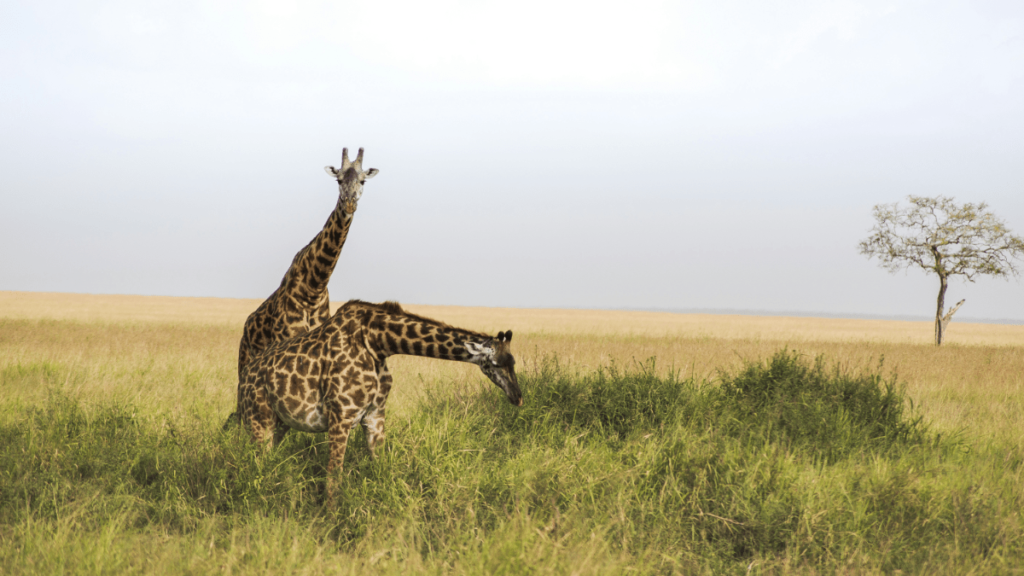
2.2 Sleep Cycles and Depth
Sleep Stages of Giraffes:
- Unlike many mammals that have distinct phases of light and deep sleep (including REM sleep), giraffes have a more fragmented sleep pattern.
- Research has shown that giraffes spend only about 4.6 hours a day sleeping, with only a small fraction of that time in deep sleep. Most of their sleep is in short intervals of 5-30 minutes, adding up to about 30 minutes of deep sleep each day.
- During deep sleep, a giraffe’s brain experiences low-frequency waves typical of deep sleep in other mammals, but these periods are very brief and interrupted.
Short Sleep Cycles:
- The brevity of giraffe sleep cycles is primarily driven by their need to stay vigilant. In the wild, giraffes are prey for lions, hyenas, and other large predators. Staying on their feet and sleeping lightly helps them detect threats quickly.
- Evolution has likely favored giraffes that sleep less but remain more alert, leading to the development of their unique sleep patterns. The minimal time spent in deep sleep reduces their vulnerability.
- The fragmented nature of their sleep, consisting of short naps rather than extended periods of rest, allows them to remain active and responsive to their environment, even during rest periods.
- The need for constant feeding also influences their sleep patterns. Giraffes are ruminants, requiring them to spend a significant amount of time chewing cud and digesting their food, which further reduces the time available for sleep.
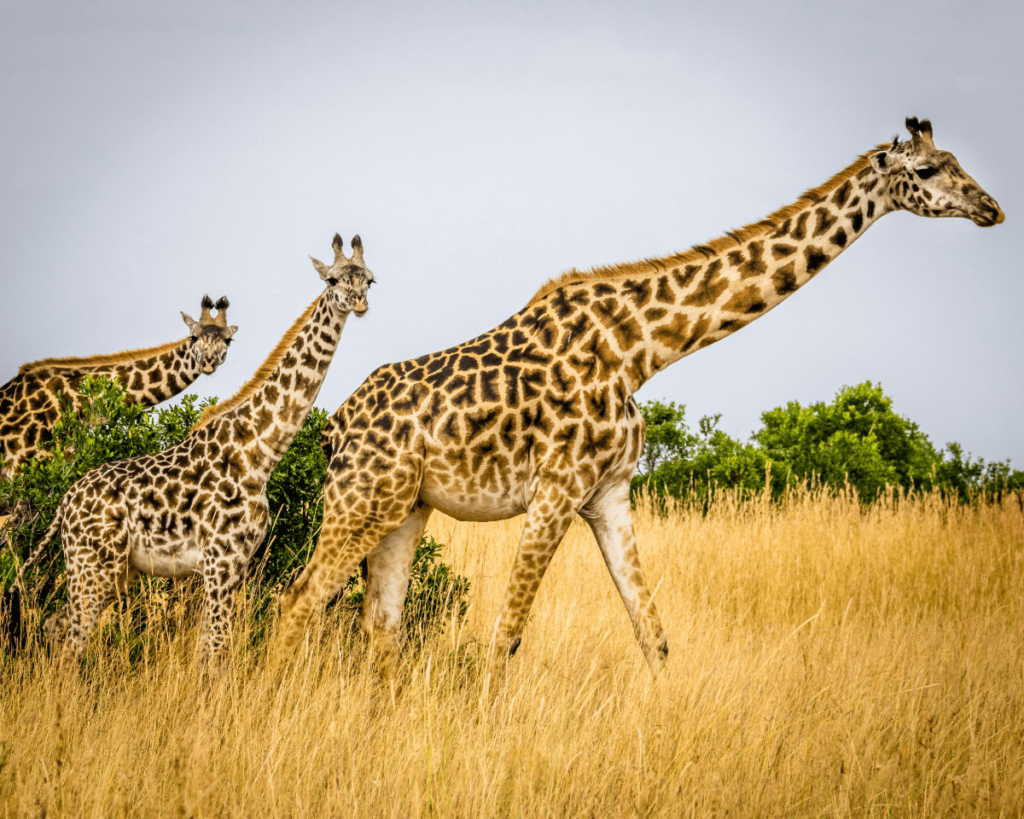
3. Reasons Behind Minimal Sleep
3.1 Evolutionary Adaptations
Need for Vigilance Against Predators:
- Giraffes are one of the tallest animals in the world, which places them at a heightened risk from predators such as lions and hyenas. This constant threat from predators has significantly influenced their sleep patterns. To enhance their chances of survival, giraffes have evolved to sleep in short, intermittent bursts rather than long, continuous periods.
- Their minimal sleep allows them to remain highly alert to potential dangers. By staying on their feet and taking brief naps, giraffes can quickly respond to threats, increasing their chances of escaping a predator.
Evolutionary Benefits of Sleeping Less:
- The evolutionary adaptation of minimal sleep provides giraffes with several survival advantages. Sleeping less helps them avoid prolonged periods of vulnerability when they are lying down, making them less susceptible to ambushes by predators.
- This adaptation also allows giraffes to maximize their feeding time. Giraffes spend much of their waking hours grazing on leaves from tall trees. A reduced sleep duration helps them efficiently manage their time between feeding and remaining vigilant.
- Evolution has favored giraffes with this sleep pattern because it increases their overall fitness and survival in the wild. By optimizing their sleep to balance vigilance and energy conservation, giraffes have adapted to thrive in their natural habitat.

3.2 Environmental and Survival Factors
Impact of Habitat and Social Structure on Sleep:
- The habitat of giraffes, typically open savannas and woodlands, requires them to stay alert for potential threats. The sparse cover in these environments makes it challenging for giraffes to find safe spots to rest. As a result, they often sleep in brief intervals, which helps them stay aware of their surroundings.
- Social structure also plays a role in their sleep patterns. Giraffes are usually found in loose herds where individuals often spread out to reduce the risk of being targeted by predators. This social arrangement means that while some giraffes are grazing or resting, others are on high alert, enhancing the herd’s overall safety and allowing for shorter, more frequent rest periods.
Role of Giraffe Behavior in Maintaining Minimal Sleep:
- Giraffes have developed specific behaviors to maximize their chances of survival while sleeping minimally. For instance, they often choose to rest during the times when predators are less active, such as early morning or late afternoon.
- Additionally, giraffes use their long necks to survey their surroundings even while resting. This unique ability allows them to keep a lookout for potential threats without needing to remain fully upright.
- Their behavior also includes periodic shifts in their resting spots to avoid predictable patterns that predators might exploit. By changing their locations frequently, giraffes reduce the likelihood of becoming easy targets for predators.
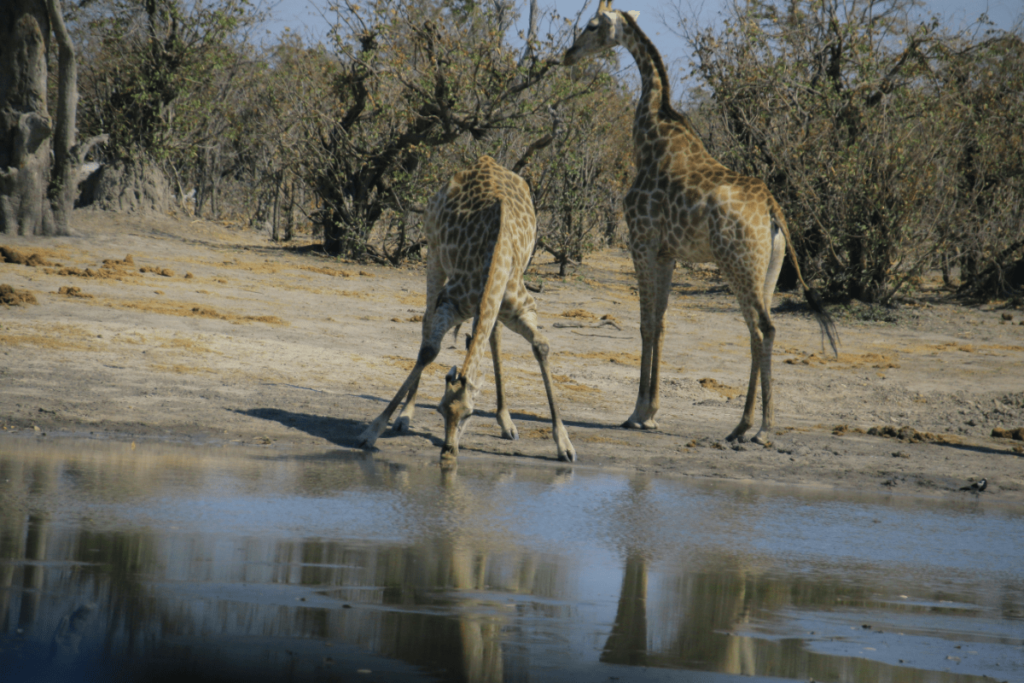
4. Comparison with Other Animals
4.1 How Giraffe Sleep Compares to Other Herbivores
Comparison with Other Large Herbivores:
- Elephants: Elephants, like giraffes, are large herbivores with unique sleep patterns. Elephants typically sleep for about 4-6 hours a day, similar to giraffes. However, unlike giraffes, elephants often lie down to sleep and have longer periods of deep sleep. They can spend up to an hour in REM sleep, a stage which giraffes rarely experience due to their brief naps.
- Check out 5 Eye-Opening Facts About Elephant’s Physical Abilities
- Cows: Domestic cows also have different sleep patterns compared to giraffes. Cows generally sleep for about 8-12 hours a day, with a significant portion of this time spent lying down. They have a more traditional sleep cycle that includes both light and deep sleep stages. In contrast, giraffes’ minimal sleep duration and fragmented sleep cycles are adaptations to their need for constant vigilance in the wild.

Behavioral and Physiological Differences:
- Giraffes’ need for vigilance influences their brief sleep duration and standing sleep posture, which is in stark contrast to the more relaxed sleep behaviors of elephants and cows. While giraffes sleep minimally to avoid predators, herbivores like cows and elephants can afford longer periods of rest due to their lower risk from predators and different social structures.
4.2 Giraffe Sleep vs. Predators
Comparison with Predators:
- Hyenas: Hyenas, which are also predators and scavengers, sleep for about 12-14 hours a day. Their sleep patterns are influenced by their complex social structures and scavenging behavior. Although they are more vigilant than lions, hyenas still experience longer periods of rest compared to giraffes, due to their relatively lower vulnerability to predators and their ability to detect threats through social interactions.
- Lions: Lions, as apex predators, have vastly different sleep patterns compared to giraffes. Lions sleep for approximately 16-20 hours a day, including long periods of deep sleep. This extensive sleep duration is supported by their position at the top of the food chain, where they face fewer threats from other animals. Unlike giraffes, lions have less need for constant vigilance and can afford longer, uninterrupted sleep cycles.
- Check out Why Lion is called King of Jungle.
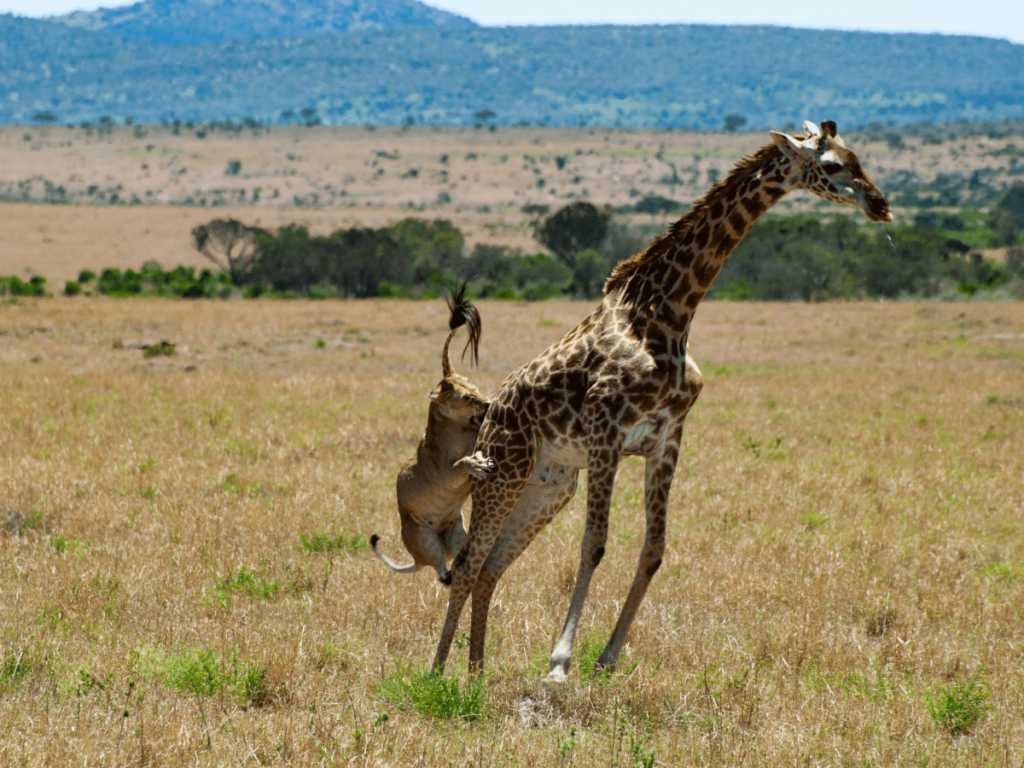
Behavioral Implications:
- The stark contrast between giraffes’ minimal sleep and the extensive sleep of predators highlights the adaptations each species has developed for survival. Giraffes’ brief, intermittent sleep helps them remain alert in their open habitats, while predators like lions and hyenas can afford more extensive rest periods due to their dominant positions in the food chain and their reduced risk of predation.
5. Impact on Health and Behavior
5.1 Effects of Limited Sleep on Giraffe Health
Potential Health Implications of Minimal Sleep:
- Cognitive and Physical Health: The limited amount of sleep that giraffes get, averaging about 4.6 hours a day, can have several health implications. Chronic sleep deprivation in giraffes may lead to reduced cognitive function and impaired decision-making abilities, though this is less studied compared to other mammals. Sleep is crucial for memory consolidation and learning, so limited sleep could affect these aspects.
- Immune System Impact: Sleep plays a vital role in maintaining a healthy immune system. The minimal sleep of giraffes could potentially lead to a weakened immune response, making them more susceptible to diseases and infections. However, there is limited research directly linking giraffe sleep patterns to immune health.
- Physical Strain: The physical strain of frequently changing positions and standing during rest periods could contribute to musculoskeletal issues. The giraffe’s long legs and neck may experience added stress, which might lead to discomfort or potential health problems over time.
Observations of Behavior Changes:
- Increased Vigilance: The need for constant alertness can lead to increased stress levels in giraffes. Observations have shown that giraffes may exhibit heightened vigilance and restlessness during periods when they are supposed to be sleeping. This behavior is a coping mechanism to stay aware of potential threats.
- Behavioral Adjustments: Some giraffes may display altered foraging and social behaviors due to their limited sleep. For example, they might spend more time grazing during twilight hours when predators are less active, adjusting their daily routines to accommodate their sleep patterns.

5.2 How Giraffes Manage Their Sleep Needs
Strategies to Cope with Unique Sleep Patterns:
- Segmented Sleep: Giraffes often engage in segmented sleep, taking multiple short naps throughout the day rather than one long sleep period. This approach allows them to stay alert while still meeting their basic rest needs.
- Resting Behavior: To manage their limited sleep, giraffes tend to rest in secure, sheltered areas where they feel safer from predators. They may also use their long necks to maintain a lookout while resting, which helps them remain aware of their surroundings even during sleep.
- Adaptive Behavior: Giraffes exhibit adaptive behaviors such as changing their resting locations frequently to avoid predictable patterns that predators could exploit. This constant adjustment helps them maintain a level of safety while minimizing the risks associated with their sleep.
Adaptations in Behavior:
- Social Structure: In herds, giraffes rely on each other for protection, allowing individuals to sleep in shorter intervals. This social structure helps distribute the vigilance duties among herd members, making it easier for each giraffe to get some rest while others stay alert.
- Feeding and Resting Patterns: Giraffes adjust their feeding and resting patterns to align with their sleep needs. They often graze during cooler parts of the day or at night to reduce the time spent in high-risk, exposed conditions. This behavioral adaptation helps them balance their need for food and rest.
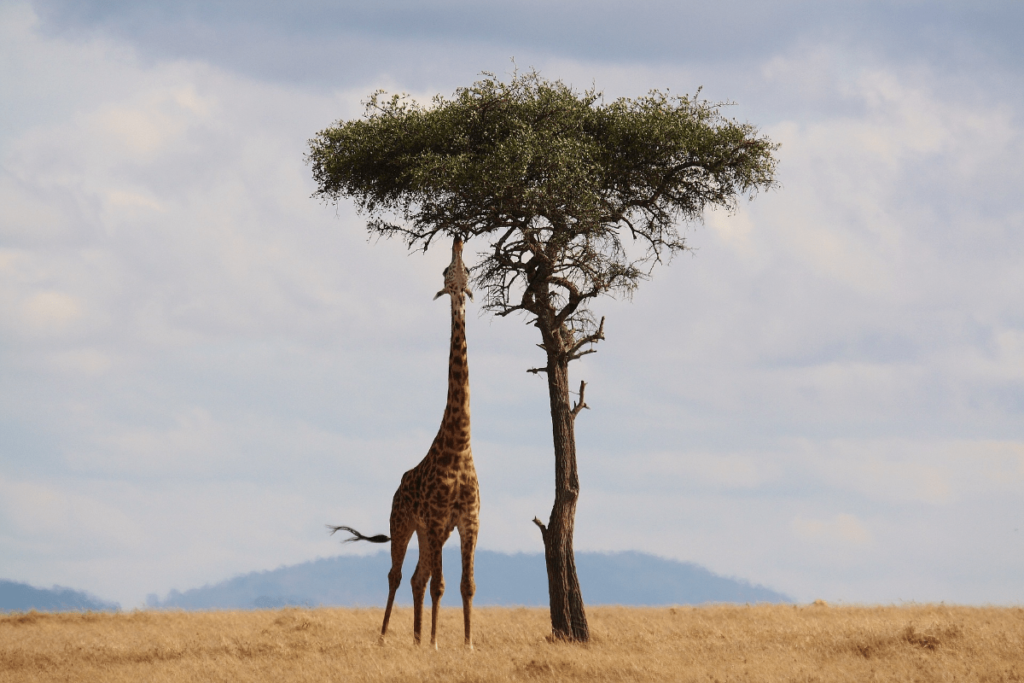
6. Fun Facts About Giraffe Sleep
6.1 Unique Giraffe Sleeping Behaviors
Interesting and Lesser-Known Facts:
- Brief Naps: Unlike most mammals, giraffes have very brief sleep cycles. They generally sleep for about 4.6 hours a day, often in short bursts. These naps are crucial for their survival, allowing them to remain alert to potential threats while still getting necessary rest.
- Standing Sleep: Giraffes are one of the few animals that can sleep while standing up. This behavior is an adaptation to their need for constant vigilance. By remaining upright, they can quickly react to any signs of danger. However, they do occasionally lie down, especially during deep sleep phases, although this is less common.
- Deep Sleep and REM: Giraffes spend very little time in REM sleep, a stage crucial for restorative processes. This limited REM sleep is a notable characteristic of their sleep patterns. Observations have shown that when giraffes do lie down to sleep, they often experience only short periods of deep sleep.
Anecdotes or Unusual Observations:
- Sleeping in Pairs: In some cases, giraffes have been observed sleeping in close proximity to each other, particularly in areas with heightened predator activity. This behavior may provide an additional layer of safety, as it allows them to remain somewhat connected and potentially detect threats more efficiently.
- Resting Positions: When lying down, giraffes may fold their legs underneath them in a way that seems almost awkward due to their long limbs. This unusual resting position helps them conserve space and stay comfortable while minimizing exposure to potential threats.
- Napping Habits: Giraffes have been seen taking quick naps while standing and resting their heads on a nearby surface, such as a tree or another giraffe. This behavior allows them to take advantage of brief moments of rest without fully lowering their guard.
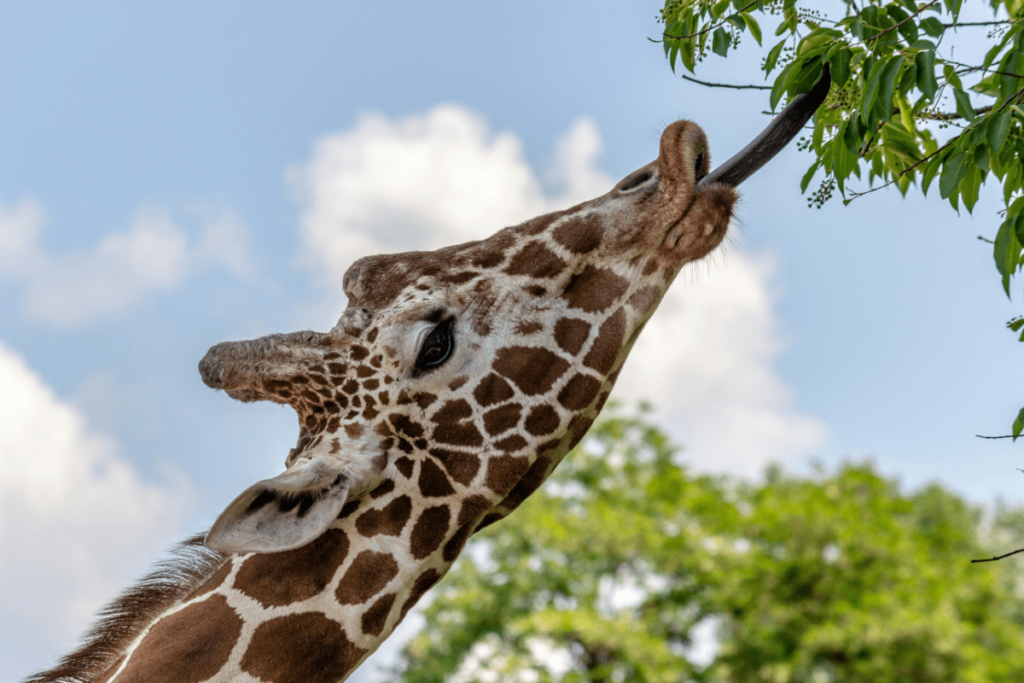
Frequently Asked Questions
How long do giraffes sleep in a day?
Giraffes sleep for about 4.6 hours a day, often in short intervals.
Do giraffes sleep standing up?
Yes, giraffes can sleep while standing up but also lie down occasionally.
Why do giraffes sleep so little?
Giraffes sleep less due to their need for constant vigilance against predators and their evolutionary adaptations.
How do giraffes manage with minimal sleep?
They take multiple short naps, rest strategically, and use their social structure for added security.
What are some interesting facts about sleeping giraffes?
Giraffes often nap while standing, sometimes rest their heads on objects, and have minimal REM sleep.
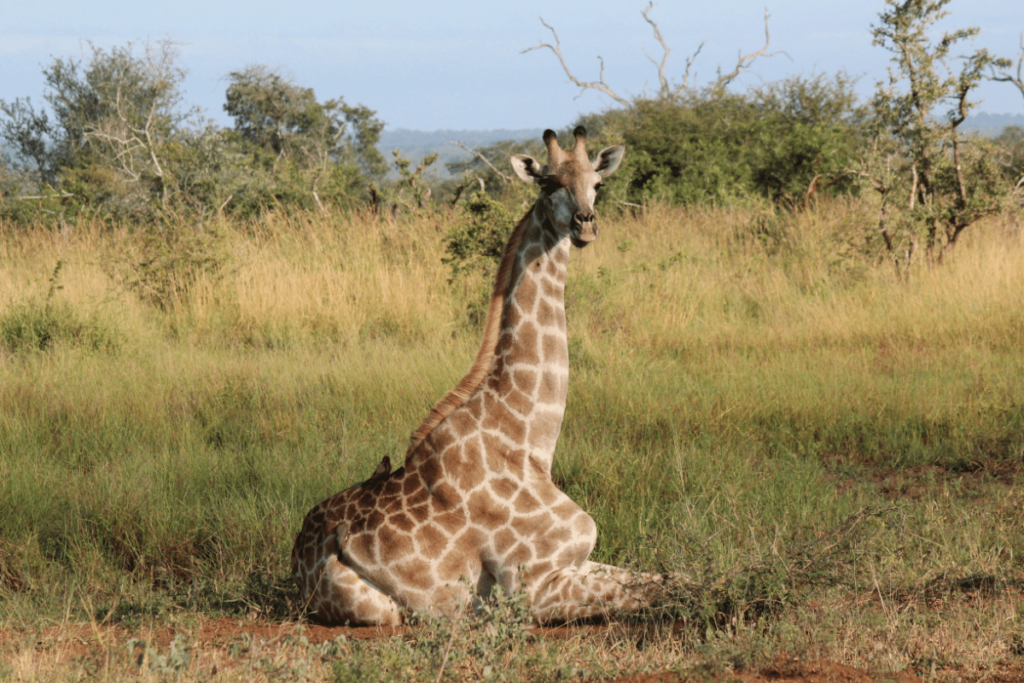
Conclusion
In this article, we explored the fascinating world of giraffe sleep, revealing that giraffes sleep for a notably brief duration, averaging around 4.6 hours a day. Their sleep patterns include both standing and lying down, although the latter is less common. We discussed the unique aspects of their sleep behavior, such as their minimal REM sleep and the evolutionary adaptations that contribute to their limited sleep. Additionally, we examined how factors like predator vigilance and environmental conditions influence their sleep needs and patterns.
The minimal sleep patterns of giraffes are a remarkable example of how animals adapt to their environments for survival. Their ability to manage limited sleep while remaining alert to potential threats showcases their resilience and evolutionary success. Understanding these unique behaviors not only highlights the giraffe’s adaptability but also underscores the importance of preserving their habitats to ensure their continued survival.
If you enjoyed learning about giraffe sleep and want to delve deeper into giraffe behavior and conservation, we encourage you to share this article with others. Feel free to leave your comments or questions below, and explore more about these incredible creatures and their fascinating adaptations.





Pingback: Do Sharks Sleep? Understanding How Sharks Rest and Recharge - primalwildlife.com